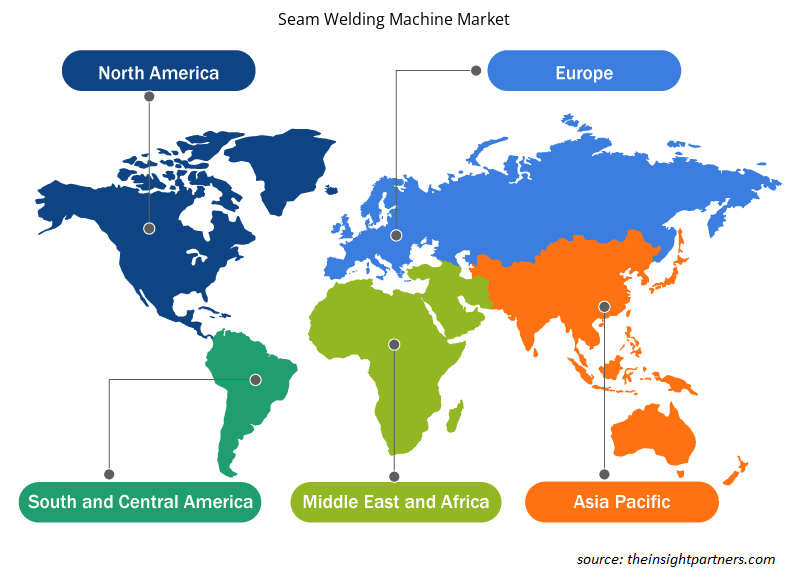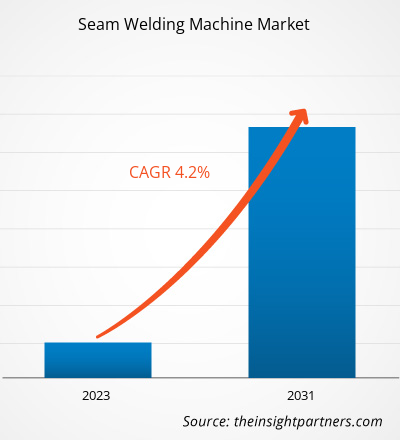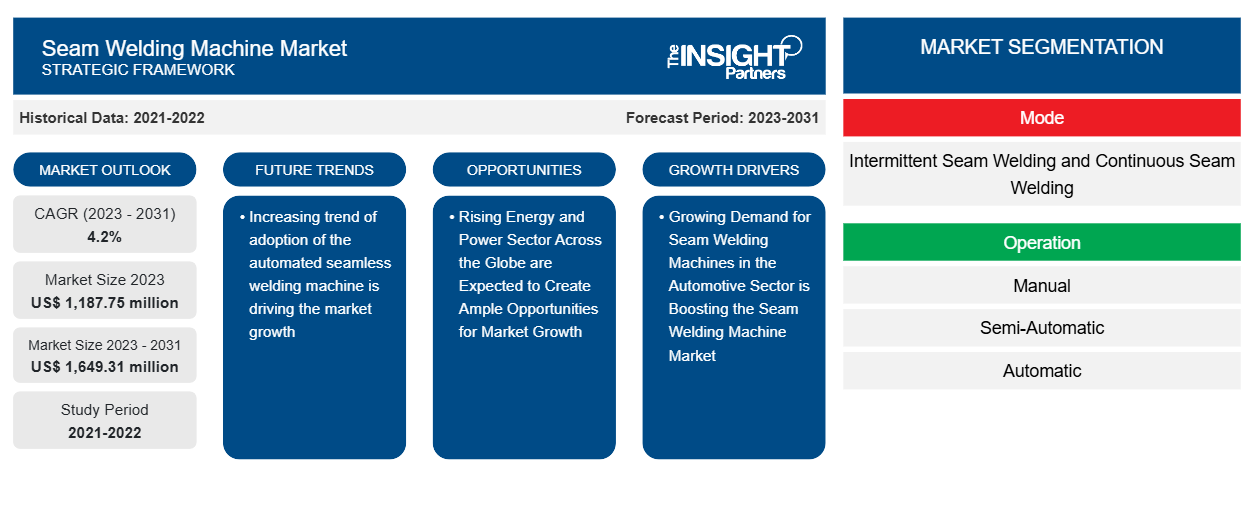Si prevede che le dimensioni del mercato delle macchine per saldatura a punti raggiungeranno 1.649,31 milioni di dollari entro il 2031, rispetto ai 1.187,75 milioni di dollari del 2023. Si prevede che il mercato registrerà un CAGR del 4,2% nel 2023-2031. Le macchine per saldatura a punti sono costituite da una o due ruote azionate da motore che creano una serie di saldature a punti sovrapposte sui componenti in lamiera di acciaio per ottenere una tenuta stagna all'aria e ai liquidi sui componenti saldati. La corrente continua passa attraverso queste lamiere a rulli e i componenti saldati vengono premuti tra di esse. La crescente domanda di macchine per saldatura a punti in diversi settori, tra cui automotive, fabbricazione industriale, energia edile ed energia, tra gli altri, guida la crescita del mercato durante il periodo di previsione.
Analisi di mercato delle macchine per saldatura a punti
Il mercato delle macchine per saldatura a punti è dominato dai paesi dell'Asia Pacifica come India, Cina, Corea del Sud, Giappone e molti altri. Ciò è dovuto alla crescente domanda da parte degli stabilimenti di produzione automobilistica nei paesi dell'Asia Pacifica che guida la crescita del mercato. Le importazioni di componenti per auto dell'India hanno raggiunto 20,3 miliardi di dollari nel 2023, con una quota significativa del 30% dalla Cina. Il governo indiano sta incrementando la produzione nazionale di veicoli elettrici e sta guidando la crescita del mercato delle macchine per saldatura a punti.
Personalizza questo report in base alle tue esigenze
Riceverai la personalizzazione gratuita di qualsiasi report, comprese parti di questo report, o analisi a livello nazionale, pacchetto dati Excel, oltre a usufruire di grandi offerte e sconti per start-up e università
-
Scopri le principali tendenze di mercato in questo rapporto.Questo campione GRATUITO includerà analisi di dati che spaziano dalle tendenze di mercato alle stime e alle previsioni.
Panoramica del mercato delle macchine per saldatura a punti
Driver e opportunità del mercato delle macchine per saldatura a punti
La crescente domanda di macchine per la saldatura a punti nel settore automobilistico sta stimolando il mercato delle macchine per la saldatura a punti
La produzione automobilistica è aumentata dell'11,5% nel 2022 rispetto al 2023, per un totale di circa 92 milioni di unità a livello globale. L'aumento della produzione determina principalmente la domanda di macchine avanzate come le saldatrici robotizzate senza saldatura per la produzione di pannelli per autoveicoli da parte dei principali OEM del settore automobilistico. Una crescita così rapida della produzione di veicoli automobilistici nelle economie avanzate a livello globale ha guidato la crescita del mercato delle macchine per saldatura a punti nel settore automobilistico. Inoltre, la crescente produzione di veicoli elettrici con l'emergere di veicoli elettrici ibridi sta guadagnando popolarità nel mercato delle macchine per saldatura a punti.
Si prevede che l'aumento del settore energetico e dell'energia in tutto il mondo creerà ampie opportunità di crescita del mercato
Si prevede che la crescente domanda di fabbricazione di supporti per pannelli solari e caldaie industriali nel settore energetico ed elettrico creerà ampie opportunità per la crescita del mercato delle macchine per saldatura a punti durante il periodo di previsione. Ad esempio, a gennaio 2024, Mortenson e Terra-Gen hanno lanciato il più grande progetto di pannelli solari e accumulo di energia denominato Edwards & Sanborn Solar negli Stati Uniti. Mortenson è l'appaltatore di servizi di approvvigionamento, ingegneria e costruzione per questo progetto negli Stati Uniti. Si prevede che l'aumento di tali progetti in tutto il mondo creerà ampie opportunità per la crescita del mercato globale delle macchine per saldatura a punti durante il periodo di previsione.Mortenson and Terra-Gen launched the largest solar panel and energy storage project named Edwards & Sanborn Solar in the US. Mortenson is the procurement, engineering, and construction service contractor for this project in the US. Increasing such projects across the globe is expected to create ample opportunity for the global seam welding machine market growth during the forecast period.
Analisi della segmentazione del rapporto di mercato delle macchine per saldatura a punti
I segmenti chiave che hanno contribuito alla derivazione dell'analisi di mercato delle macchine per saldatura a rulli sono modalità, funzionamento e settore.
- In base alla modalità, il mercato è segmentato in saldatura a punti intermittente e saldatura a punti continua. Tra queste, la saldatura a punti continua ha la quota maggiore a causa della crescente domanda nella produzione automobilistica in tutto il mondo.
- In base al funzionamento, il mercato delle macchine per la saldatura a rulli è suddiviso in manuale, semiautomatica e automatica.
- In base al settore, il mercato è segmentato in edilizia, automotive, petrolio e gas, produzione e altri. Tra questi, l'industria automobilistica ha la quota maggiore nel 2023, questo è dovuto all'aumento della produzione automobilistica in tutto il mondo.
Analisi della quota di mercato delle macchine per saldatura a punti per area geografica
L'ambito geografico del rapporto di mercato sulle macchine per saldatura a rulli è suddiviso principalmente in cinque regioni: Nord America, Asia Pacifico, Europa, Medio Oriente e Africa e Sud America/Sud e Centro America.
In base alla geografia, il mercato delle macchine per saldatura a punti è principalmente segmentato in Nord America, Europa, Asia Pacifico (APAC), Medio Oriente e Africa (MEA) e Sud America (SAM). Si prevede che l'Asia Pacifico rappresenti la quota di mercato maggiore nel 2023 ed è probabile che mantenga il suo predominio durante il periodo di previsione. Inoltre, si prevede che il mercato delle macchine per saldatura a punti in questa regione registrerà il CAGR più elevato durante il periodo di previsione. Ciò è dovuto all'aumento della produzione automobilistica nei paesi dell'Asia Pacifico come Cina, Giappone e India. Ad esempio, nel 2023, i produttori automobilistici indiani hanno pianificato di investire oltre 7 miliardi di dollari entro il 2028 per rafforzare la produzione locale di componenti automobilistici, come motori elettrici, pannelli per auto, telai e molti altri. Inoltre, a marzo 2024, Autoneum ha pianificato di espandere la sua produzione nei paesi dell'Asia Pacifico come Cina e India. L'azienda ha pianificato di aprire due nuovi stabilimenti a Pune nell'India occidentale e a Changchun a Jilin, in Cina. L'aumento di tali investimenti nel settore automobilistico nei paesi dell'area Asia-Pacifico ha creato una domanda enorme per la crescita del mercato delle macchine per saldatura continua.
Si prevede che l'Europa deterrà la seconda quota maggiore del mercato delle macchine per saldatura a punti nel 2023. Al contrario, si prevede che la Germania sarà il principale contributore al mercato regionale delle macchine per saldatura a punti. L'Europa ospita le principali case automobilistiche, tra cui Mercedes, Volkswagen, Skoda, BMW e Audi. Secondo il Policy Department for Economic, Scientific, and Quality of Life Policies, la pandemia di COVID-19 ha avuto un impatto indiretto su oltre 1,1 milioni di posti di lavoro a causa della chiusura delle fabbriche automobilistiche da marzo a maggio 2020.
Inoltre, le vendite di veicoli sono crollate in tutta Europa nel 2020, mentre i produttori di apparecchiature originali (OEM) hanno annunciato ulteriori ritardi nella riapertura dei loro impianti di assemblaggio. Oltre a un calo della domanda di autovetture e veicoli commerciali leggeri, le interruzioni nelle catene di fornitura delle materie prime dovute alle limitazioni ai movimenti transfrontalieri hanno portato a ritardi nella fornitura di attrezzature, come le saldatrici . Tuttavia, la pandemia di COVID-19 e le sue ripercussioni hanno incoraggiato le aziende manifatturiere a digitalizzare e automatizzare le loro operazioni, il che ha consentito loro di rilanciarle alla fine del 2020. Tali sforzi di rilancio da parte delle aziende manifatturiere stanno creando future opportunità di crescita per i fornitori di macchine per saldatura a punti in Europa.
Approfondimenti regionali sul mercato delle macchine per saldatura a punti
Le tendenze regionali e i fattori che influenzano il mercato delle macchine per saldatura a punti durante il periodo di previsione sono stati ampiamente spiegati dagli analisti di Insight Partners. Questa sezione discute anche i segmenti e la geografia del mercato delle macchine per saldatura a punti in Nord America, Europa, Asia Pacifico, Medio Oriente e Africa e America meridionale e centrale.

- Ottieni i dati specifici regionali per il mercato delle macchine per saldatura a punti
Ambito del rapporto di mercato sulle macchine per saldatura a punti
| Attributo del report | Dettagli |
|---|---|
| Dimensioni del mercato nel 2023 | 1.187,75 milioni di dollari USA |
| Dimensioni del mercato entro il 2031 | 1.649,31 milioni di dollari USA |
| CAGR globale (2023-2031) | 4,2% |
| Dati storici | 2021-2022 |
| Periodo di previsione | 2023-2031 |
| Segmenti coperti |
Per modalità
|
| Regioni e Paesi coperti |
America del Nord
|
| Leader di mercato e profili aziendali chiave |
|
Densità degli attori del mercato: comprendere il suo impatto sulle dinamiche aziendali
Il mercato delle macchine per la saldatura a punti sta crescendo rapidamente, spinto dalla crescente domanda degli utenti finali dovuta a fattori quali l'evoluzione delle preferenze dei consumatori, i progressi tecnologici e una maggiore consapevolezza dei vantaggi del prodotto. Con l'aumento della domanda, le aziende stanno ampliando le loro offerte, innovando per soddisfare le esigenze dei consumatori e capitalizzando sulle tendenze emergenti, il che alimenta ulteriormente la crescita del mercato.
La densità degli operatori di mercato si riferisce alla distribuzione di aziende o società che operano in un particolare mercato o settore. Indica quanti concorrenti (operatori di mercato) sono presenti in un dato spazio di mercato in relazione alle sue dimensioni o al valore di mercato totale.
Le principali aziende che operano nel mercato delle macchine per saldatura a punti sono:
- Azienda Emerson Electric
- Dahching elettrico industriale
- FranzanKoike Aronson
- Inc.
- Tecnologie Leister
- CruxweldMiller
Disclaimer : le aziende elencate sopra non sono classificate secondo un ordine particolare.

- Ottieni una panoramica dei principali attori del mercato delle macchine per saldatura a punti
Notizie di mercato e sviluppi recenti delle macchine per la saldatura a punti
Il mercato delle macchine per saldatura a punti viene valutato raccogliendo dati qualitativi e quantitativi dopo la ricerca primaria e secondaria, che include importanti pubblicazioni aziendali, dati associativi e database. Di seguito è riportato un elenco di sviluppi nel mercato per innovazioni, espansione aziendale e strategie:
- Nel 2022, Stealth, un esperto globale nella produzione di attrezzature ad alte prestazioni, ha lanciato una tecnologia di saldatura a punti brevettata, la prima sul mercato, che elimina la necessità di cuciture. La tecnologia si traduce in cuciture più calde, più resistenti e completamente durevoli per prodotti più duraturi che proteggono gli avventurieri dagli elementi più difficili. (Fonte: Eurofins, comunicato stampa)
- Nel 2022, Miller Electric ha lanciato un sistema di saldatura MIG Hercules ad alta deposizione automatizzato a filo singolo. Il sistema di saldatura Hercules migliora la capacità di saldatura senza requisiti di costo aggiuntivi correlati alle celle di saldatura. Si tratta di una macchina per saldatura senza soluzione di continuità con elevati tassi di deposizione e migliora la produttività fino al 30%. (Fonte: SGS, Newsletter)
Copertura e risultati del rapporto di mercato sulle macchine per saldatura a punti
Il rapporto "Dimensioni e previsioni del mercato delle macchine per saldatura a punti (2021-2031)" fornisce un'analisi dettagliata del mercato che copre le seguenti aree:
- Dimensioni e previsioni del mercato delle macchine per saldatura a punti a livello globale, regionale e nazionale per tutti i principali segmenti di mercato coperti dall'ambito
- Dinamiche di mercato come fattori trainanti, vincoli e opportunità chiave
- Tendenze del mercato delle macchine per saldatura a punti
- Analisi PEST dettagliata e analisi SWOT
- Analisi di mercato delle macchine per saldatura a punti che copre le principali tendenze del mercato, il quadro globale e regionale, i principali attori, le normative e i recenti sviluppi del mercato.
- Analisi del panorama del settore e della concorrenza delle macchine per la saldatura a punti, che comprende la concentrazione del mercato, l'analisi della mappa termica, i principali attori e gli sviluppi recenti.
-
Profili aziendali dettagliati
- Azienda Emerson Electric
- Dahching elettrico industriale
- Francese
- di Koike Aronson, Inc.
- Tecnologie Leister
- Saldatura a croce
- Saldatrice Miller
- Costruzione di macchinari a breve termine
- Spiro Internazionale
- Analisi storica (2 anni), anno base, previsione (7 anni) con CAGR
- Analisi PEST e SWOT
- Valore/volume delle dimensioni del mercato - Globale, Regionale, Nazionale
- Industria e panorama competitivo
- Set di dati Excel
Report recenti
Rapporti correlati
Testimonianze
Motivo dell'acquisto
- Processo decisionale informato
- Comprensione delle dinamiche di mercato
- Analisi competitiva
- Analisi dei clienti
- Previsioni di mercato
- Mitigazione del rischio
- Pianificazione strategica
- Giustificazione degli investimenti
- Identificazione dei mercati emergenti
- Miglioramento delle strategie di marketing
- Aumento dell'efficienza operativa
- Allineamento alle tendenze normative























 Ottieni un campione gratuito per - Mercato delle macchine per saldatura continua
Ottieni un campione gratuito per - Mercato delle macchine per saldatura continua